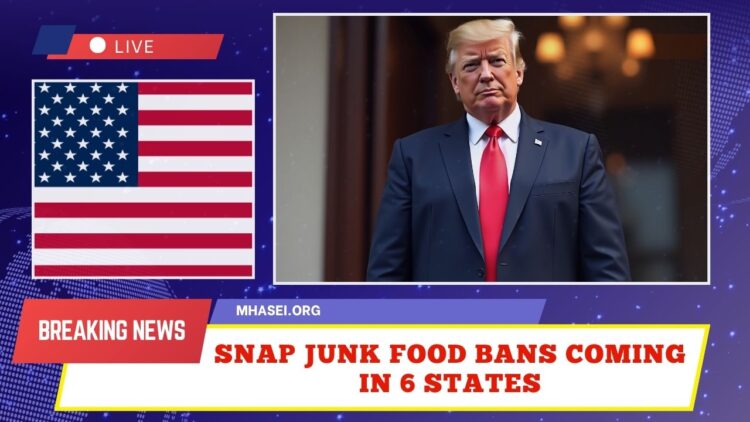The Supplemental Nutrition Assistance Program (SNAP) is undergoing one of its most significant changes in recent years, with six states moving forward to impose new restrictions on what SNAP benefits can be used for.
Starting in 2026, households receiving benefits in Colorado, Louisiana, Oklahoma, West Virginia, Texas, and Florida will see new limits placed on purchases, particularly targeting processed and sugary foods.
This decision comes after federal approval granted waivers to these states, expanding a policy movement that began with Nebraska earlier this year.
The intention, according to policymakers, is to realign SNAP with its original purpose: helping low-income households access nutritious, essential foods rather than funding items that could contribute to chronic illnesses such as diabetes and obesity.
Why These Restrictions Are Being Introduced
Officials argue that the changes are rooted in public health and fiscal responsibility. Agriculture Secretary Brooke Rollins emphasized that SNAP was created as a nutrition program to provide healthy food assistance, not to subsidize unhealthy habits.
At the same time, Health Secretary Robert F. Kennedy Jr. linked the new restrictions to his “Make America Healthy Again” initiative, explaining that taxpayers should not be funding products that increase long-term healthcare costs.
He highlighted how Medicaid and Medicare often bear the burden of treating diet-related illnesses, and these policy shifts are intended to address the problem at its source.
Pushback and Criticism
Despite strong political support, the restrictions have generated sharp criticism from food policy experts. Analysts note that SNAP currently covers around 650,000 food and beverage items, with nearly 20,000 new products entering the market each year.
Implementing state-specific prohibitions on processed foods will require significant upgrades to point-of-sale technology and monitoring systems.
Economists also warn that the bans may create confusion among retailers and shoppers while raising administrative costs. Critics argue that restricting food choices does not necessarily improve nutrition, since households may simply substitute one type of processed item for another still allowed under the rules.
The Broader Impact on Families
For families relying on SNAP, these changes mean adjusting shopping habits. Items such as sugary drinks, certain processed snacks, and energy beverages are expected to be among the first to be restricted.
Instead, families will be encouraged to purchase fresh fruits, vegetables, dairy products, cereals, grains, and proteins. The emphasis is on steering households toward healthier groceries while reducing taxpayer funding for products viewed as contributing to poor health outcomes.
Current Benefit Levels for 2025
While restrictions loom for 2026, the program’s benefit amounts remain consistent for fiscal year 2025, covering the period from October 1, 2024, through September 30, 2025.
Monthly maximum benefits are $292 for a single person, $536 for two people, $768 for three, and $975 for a family of four. Larger households also receive proportionally higher benefits, with an eight-person household eligible for $1,756 per month and an additional $220 per extra member.
| Household Size | Maximum Monthly SNAP Benefit 2025 |
|---|---|
| 1 Person | $292 |
| 2 People | $536 |
| 3 People | $768 |
| 4 People | $975 |
| 5 People | $1,158 |
| 6 People | $1,390 |
| 7 People | $1,536 |
| 8 People | $1,756 |
| Each Additional | +$220 |
What Can Still Be Purchased
Even with new state-level restrictions, SNAP’s core federal rules remain the same. Benefits can be used for fresh, frozen, and canned fruits and vegetables; meat, poultry, fish, and eggs; dairy products; cereals and grains; and non-alcoholic beverages. Households can also buy seeds and plants to grow their own food.
Excluded items continue to include alcohol, tobacco, hot prepared meals, pet food, vitamins, supplements, and non-food items. Seniors and individuals with disabilities in certain circumstances may still use benefits at participating restaurants, but these are exceptions rather than the rule.
The decision to let six states move forward with SNAP restrictions marks a turning point in how the program is managed at the state level.
Supporters see it as a way to encourage healthier eating and reduce long-term healthcare costs, while critics fear it will complicate administration and unfairly limit choice for low-income families.
For now, the debate continues, but by 2026, millions of households in Colorado, Louisiana, Oklahoma, West Virginia, Texas, and Florida will be directly affected by these changes.
FAQs
Which states are introducing new SNAP restrictions?
Colorado, Louisiana, Oklahoma, West Virginia, Texas, and Florida will begin implementing restrictions in 2026.
What foods are being restricted?
Sugary drinks, processed snacks, and energy beverages are among the items expected to be excluded from SNAP purchases.
Do these restrictions change the benefit amount?
No, benefit amounts for 2025 remain unchanged. The restrictions only apply to what products can be purchased with benefits.




